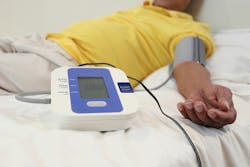The New Jersey-based Camden Coalition is piloting a short-term, home-based intervention with patients living with hypertension in combination with other complex health and social needs. Jubril Oyeyemi, M.D., medical director, and Michelle Adyniec, R.N., B.S.N., senior clinical manager, of Camden Coalition’s Care Management Initiatives, recently spoke with Healthcare Innovation about the project.
The researchers point out that high blood pressure is one of the most prevalent chronic conditions in the United States, with nearly half of adults carrying a diagnosis of hypertension. The group’s data shows that up to two-thirds of participants in their Camden Core Model care management program have a cardiovascular diagnosis.
The Care Management team has enrolled 62 patients and expects to release a complete set of findings after enrollment and data analysis is complete.
Healthcare Innovation: For our readers who aren't familiar with it, can you briefly describe the broader Camden Core Model care management program?
Adyniec: Our Camden Core Model has traditionally focused on working with people who have going in and out of the hospital a lot. These are people who are clearly not getting their needs met through going to the ER or even in their inpatient visits. These people obviously have a high level of complexity. They probably need more support than what they're getting from these quick touch points in an acute-care setting. So we built the Core Model based around working with those patients. We identify them through our health information exchange, go to the bedside, and really the work has developed out of talking to them, understanding what their needs are, and then responding to that and building a program. The Core Model is able to respond to both medical and social complexity, and is really focused on whole-person care. What are the biggest needs from their perspective, and how can we plug them into the right supports to make them more successful in the community setting?
HCI: Could you talk about why you sought to do a targeted intervention on blood pressure management for complex care?
Adyniec: Our Core Model doesn't specifically target one disease state. But we learned from previously doing some work on improving colonoscopy rates in our population that when we do focus on one specific disease state, we learn that we can really get a clearer picture of how the system works around that disease state. Because our healthcare world thinks in disease states, it also helps us figure out how to map our whole-person approach on to the way that our partners are thinking about things.
HCI: Did you also find that that high blood pressure was highly prevalent amongst the people in the program?
Oyeyemi: What we found in enrolling folks and and debriefing with care management weekly was that it was often that a person’s medical complexity started with hypertension, and the prevalence was almost 50 percent, and for me as a physician, it feels like even more than that. So that's why we thought to focus on hypertension. We thought that's a good simple place to start with an eight-week blood pressure management program. That's the hook, if you will — by paying attention to the blood pressure, what we found inevitably was that it was just a window into a whole bunch of other things, because when you go to support someone in addressing their blood pressure, you find a whole bunch of other things that our team was really well equipped to manage because of all the other work that we've done over the last few decades.
HCI: One of the project’s stated goals is to identify relevant implications for Medicaid operations, including ease of access to blood pressure cuffs, medications, and prior authorization, and generate some hypotheses about the use of the ED by these patients and connections to primary care. Is it possible that this study will show reduced use of the ED by this cohort, making it more attractive to Medicaid managed care organizations?
Adyniec: It is possible. With some of our patients, we're already seeing that that is the case. When we were talking about implications for Medicaid, we were thinking more specifically about the access to in-home blood pressure monitoring equipment. Although it is covered by Medicaid, what we're finding is a lot of providers and patients think that it is not because the process the MCOs use is a durable medical equipment process, which is very complex. Usually when patients need medical equipment, there's some support built up around helping them through that process. You’d think that you'd be able to get a blood pressure monitor from a pharmacy like you would other small equipment like blood sugar monitors, but you can’t. It is just a very complex process. We want to collect some data on that and make sure that Medicaid is aware of that barrier for our patients. Also, we did not know what to expect as far as whether people with complex health and social needs have too much going on to really be able to use it and be consistent with it. We have been very impressed so far with how many patients really are using their blood pressure cuffs at home daily are providing those readings to our teams.
HCI: I understand that with this research you wanted to study how the community-based care management program can serve as an extension of primary care for these individuals with complex health and social needs. Is one of the goals to get the primary care team more involved in this ongoing monitoring of the patient's progress with their blood pressure?
Adyniec: What we're learning is that primary care needs to figure out how to do some amount of in-home visits because you just get so much more information from one visit in the home. Our nurses always start the intervention with an in-home med reconciliation, figuring out what are they really taking versus what are they prescribed. They also get some information that you would not get when you do a visit in an office setting. They can notice if the medications are still in their pharmacy bags and can open up conversations around how they're taking their medications. Obviously it’s not easy for primary care to be able to do in-home work. But organizations like ours that have expertise in doing in-home visits could partner and add so much more information for the primary care providers about what's really going on with that patient.
Oyeyemi: When we were designing this pilot, one question was how translatable this was going to be in a traditional primary care setting, because for many reasons, a lot of primary care offices today don't even have nurses. It's usually a team of medical assistants. This program provides two nursing visits over the eight weeks and then weekly touch points with community health workers, after you've forged a relationship with them. One of the things we're thinking about is, could there be a future model where traditional practices that don't staff nurses anymore decide to refer to a community-based organization that does work like this?
HCI: Could you talk about some of the process measures or clinical metrics you're tracking through the program?
Oyeyemi: Certainly the blood pressure — a lot of times we're enrolling folks in the ER or on the inpatient unit after they've gone through a hypertensive emergency after many years of struggling with blood pressure management. We're watching the blood pressure to see how much reduction there is when all the data is compiled. We are also looking at medication adherence. This is one that a lot of primary care doctors like myself are completely in the dark about. But when our nurses and our community health workers meet the person, they might find that there are packets of meds that haven't been opened. That can open up conversations. It may not be that they don't want to take it; it may be there's a side effect that is not well tolerated, or there's some other barrier.
Adyniec: We have a few metrics that focus on patient engagement: Are people engaging with this program? That's always a really important thing for us to evaluate. Is this important to them? Are we doing it in a way that's engaging to them? How long are they staying with us? Are they completing the program? How engaged are they with actually checking their own blood pressure? And then we're also tracking how successful we are with making sure that this really valuable information that we collected is actually getting back to the doctor.
I think we underestimate the value in building agency from just being able to control something as simple as my blood pressure. We've been really impressed with how engaged patients have been. When we do get them on medication regimens that are optimal for them, people are really having a lot of success in the program.
Hypertension is something that that we often call a silent killer. And in the population we serve that's disproportionately affected by cardiovascular complications from this silent killer, it’s kind of nice to see it taken more seriously. One of the things I'm hoping is that we can take things we've learned from a population this complex and perhaps translate into how it's managed in other less complex scenarios.
HCI: Anything else you want to add about this project?
Oyeyemi: One other thing I wanted to say is that I know historically our work at the Coalition was done in the setting of readmissions and lowering hospitalizations. I just want to point out that while that's still a thing to be mindful of, we've since learned that patient-centered outcomes are the way to go because then you're working together on a goal that then inevitably impacts those metrics that we're trying to impact, and blood pressure is one of them. In this pilot, for instance, blood pressure is what people are focused on, but what we find is that it parallels other things that they also want to work on, whether that’s housing, whether that's connection to addiction treatment, or some other goal — reconnecting with family members. So it's kind of interesting to combine a metric that's measurable, like hypertension, while you're also working on some of these other heavy, heavy goals. I can tell you as someone who was a hospital doc before, when someone came in and they were struggling with homelessness, and oh, by the way, they've got like a 15-item list of problems, hypertension is low on that list. You're not even thinking about the hypertension. They don't have a place to rest their head, right? But what we're finding is that the blood pressure can be the anchor as you work on housing, on transportation, on SNAP benefits and connecting them to social services.


